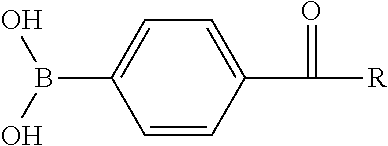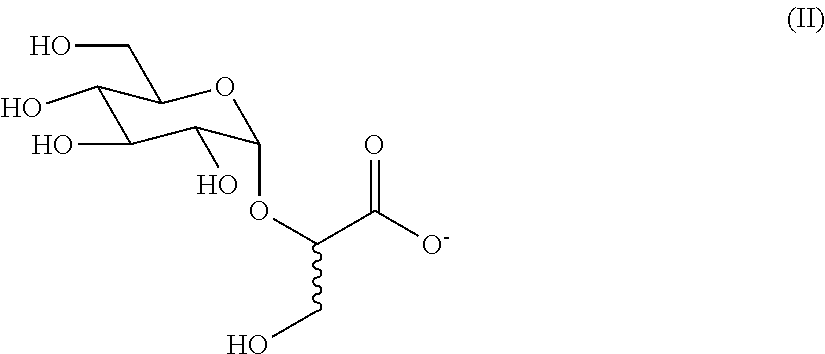Method for adapting a hydrolytic enzyme to a component that stabilizes the hydrolytic enzyme
a technology of hydrolytic enzyme and hydrolytic enzyme, which is applied in the field of enzyme technology, can solve the problems of unsatisfactory cleaning performance, unsatisfactory secondary products, and no longer exhibit optimal cleaning performan
- Summary
- Abstract
- Description
- Claims
- Application Information
AI Technical Summary
Benefits of technology
Problems solved by technology
Method used
Image
Examples
example 1
Adapting a Protease to Given Compounds that Inhibit and Thus Stabilize the Protease
[0186]All molecular-biological work was carried out by standard methods as can be found, for example, in the manual by Fritsch, Sambrook and Maniatis “Molecular cloning: a laboratory manual”, Cold Spring Harbour Laboratory Press, New York, 1989, or comparable specialist literature. Enzymes and kits were used according to the directions of the relevant manufacturer.
[0187]A protease according to SEQ ID NO: 3 was used as the hydrolytic enzyme (starting enzyme). Furthermore, the following listed reversible protein inhibitors were each provided as the component that stabilizes the hydrolytic enzyme:[0188]1. Boric acid[0189]2. 4-Formylphenylboronic acid (4-FPBA)[0190]3. 3-Hydroxyphenylboronic acid (3-HPBA)[0191]4. Benzylmalonic acid (BMA)
[0192]The nucleic acid sequence of the hydrolytic enzyme present on a plasmid was modified individually or in combination as indicated in Tables 1 and 2 using site directed...
example 2
Inhibition Measurements in the Biochemical Test
[0197]The variants S166V and S166G / Q191R as well as the starting enzyme according to SEQ ID NO: 3 were expressed in a suitable expression system, further purified by means of ion exchange chromatography and prepared for the activity determinations in 0.1 M Tris / HCl buffer pH 8.6, comprising Brij35. To the formulations were added increased amounts of the reversible inhibitor 3-HPBA or BMA (see Tables 3 and 4) and the proteolytic residual activity of the respective protease was determined from the release of the chromophore para-nitroaniline (pNA) from the substrate suc-L-Ala-L-Ala-L-Pro-L-Phe-p-nitroanilide (suc-AAPF-pNA) as described above. The obtained activities are shown in the Tables 3 and 4.
TABLE 3Without3-HPBA (in mM)Enzymeinhibitor0.050.10.511.5Starting100%93%89%81%65%56%enzymeS166V100%84%87%65%51%40%
TABLE 4With-outinhib-BMA (in Gew.-%)Enzymeitor0.050.51.01.72.53.34.05.0Starting100%96%95%93%94%74%73%78%64%enzymeS166G / 100%88%55%42...
example 3
Determination of the Storage Stability in a Liquid Surfactant Preparation
[0199]The variants S166V and S166G / Q191R as well as the starting enzyme according to SEQ ID NO: 3 were added in equal concentration to reaction formulations that comprised a surfactant preparation as described in Example 1 as well as a reversible inhibitor in concentrations indicated in Table 5. The formulations were stored at 30° C. and the remaining proteolytic residual activity of the protease was determined at regular intervals from the release of the chromophore para-nitroaniline (pNA) from the substrate suc-L-Ala-L-Ala-L-Pro-L-Phe-p-nitroanilide (suc-AAPF-pNA) as described above. The addition of the inhibitors lead to the increased factors of the half-life times indicated in Table 5 (half-life with inhibitor divided by half-life without inhibitor).
TABLE 5Boricacid3-HPBA(in wt %)(in wt %)BMA (in wt %)Enzyme10.250.020.0051Starting enzyme2641453S166V436349n.d.S166G / Q191Rn.d.n.d.n.d.n.d.5(n.d.: not determined...
PUM
| Property | Measurement | Unit |
|---|---|---|
| length | aaaaa | aaaaa |
| shelf stability | aaaaa | aaaaa |
| enzyme activity | aaaaa | aaaaa |
Abstract
Description
Claims
Application Information
 Login to View More
Login to View More - R&D
- Intellectual Property
- Life Sciences
- Materials
- Tech Scout
- Unparalleled Data Quality
- Higher Quality Content
- 60% Fewer Hallucinations
Browse by: Latest US Patents, China's latest patents, Technical Efficacy Thesaurus, Application Domain, Technology Topic, Popular Technical Reports.
© 2025 PatSnap. All rights reserved.Legal|Privacy policy|Modern Slavery Act Transparency Statement|Sitemap|About US| Contact US: help@patsnap.com



